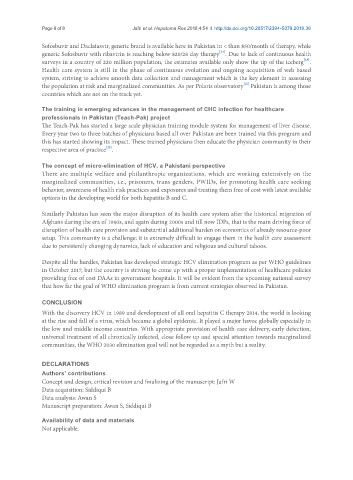Page 571 - Read Online
P. 571
Page 6 of 8 Jafri et al. Hepatoma Res 2018;4:54 I http://dx.doi.org/10.20517/2394-5079.2018.36
Sofosbuvir and Daclatasvir, generic brand is available here in Pakistan in < than $50/month of therapy, while
[24]
generic Sofosbuvir with ribavirin is reaching below $20/28 day therapy . Due to lack of continuous health
[28]
surveys in a country of 220 million population, the estimates available only show the tip of the iceberg .
Health care system is still in the phase of continuous evolution and ongoing acquisition of web based
system, striving to achieve smooth data collection and management which is the key element in assessing
[11]
the population at risk and marginalized communities. As per Polaris observatory Pakistan is among those
countries which are not on the track yet.
The training in emerging advances in the management of CHC infection for healthcare
professionals in Pakistan (Teach-Pak) project
The Teach-Pak has started a large scale physician training module system for management of liver disease.
Every year two to three batches of physicians based all over Pakistan are been trained via this program and
this has started showing its impact. These trained physicians then educate the physician community in their
[29]
respective area of practice .
The concept of micro-elimination of HCV, a Pakistani perspective
There are multiple welfare and philanthropic organizations, which are working extensively on the
marginalized communities, i.e., prisoners, trans genders, PWIDs, for promoting health care seeking
behavior, awareness of health risk practices and exposures and treating them free of cost with latest available
options in the developing world for both hepatitis B and C.
Similarly Pakistan has seen the major disruption of its health care system after the historical migration of
Afghans during the era of 1980s, and again during 2000s and till now IDPs, that is the main driving force of
disruption of health care provision and substantial additional burden on economics of already resource-poor
setup. This community is a challenge; it is extremely difficult to engage them in the health care assessment
due to persistently changing dynamics, lack of education and religious and cultural taboos.
Despite all the hurdles, Pakistan has developed strategic HCV elimination program as per WHO guidelines
in October 2017, but the country is striving to come up with a proper implementation of healthcare policies
providing free of cost DAAs in government hospitals. It will be evident from the upcoming national survey
that how far the goal of WHO elimination program is from current strategies observed in Pakistan.
CONCLUSION
With the discovery HCV in 1989 and development of all oral hepatitis C therapy 2014, the world is looking
at the rise and fall of a virus, which became a global epidemic. It played a major havoc globally especially in
the low and middle income countries. With appropriate provision of health care delivery, early detection,
universal treatment of all chronically infected, close follow up and special attention towards marginalized
communities, the WHO 2030 elimination goal will not be regarded as a myth but a reality.
DECLARATIONS
Authors’ contributions
Concept and design, critical revision and finalizing of the manuscript: Jafri W
Data acquisition: Siddiqui B
Data analysis: Awan S
Manuscript preparation: Awan S, Siddiqui B
Availability of data and materials
Not applicable.

